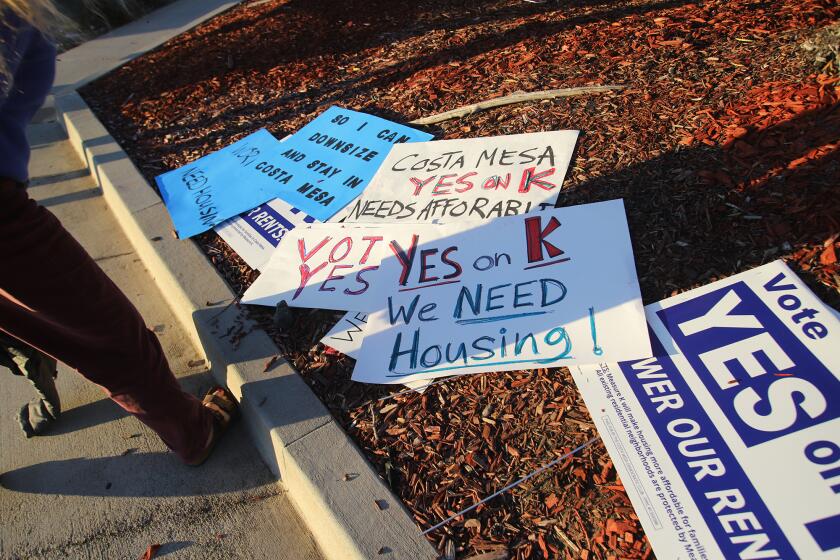Apodaca: Construction snarls drop-off and pick-up
- Share via
If our alien overlords ever return to Earth to check on how we lowly humans are faring, I hope they don’t decide to show up during school drop-off and pick-up times.
Here’s what they’d find: over-caffeinated parents drag racing their SUVs to get their children to school on time; kids running across busy intersections and dodging cars in school parking lots; new teen drivers navigating bumper-to-bumper traffic and hair-raising turns as they compete for prime parking spots; and cranky neighbors who wish it would all go away.
Not exactly a showcase of humanity at its finest.
What’s worse, this year, the chaos threatens to reach new levels at two of Newport-Mesa’s most populated campuses. Costa Mesa and Corona del Mar high schools have major construction projects underway that have added to their usual assortment of traffic and parking woes.
Both schools have torn down older structures to add theaters and separate middle-school “enclaves” for their seventh- and eighth-grade students. The projects, which are expected to take two to three years, are being paid for with funds from the Measure F bond issue passed by voters in 2005.
Aggravating as they are, it’s tough to affix blame for the school-generated traffic problems, as they are largely a byproduct of maturing neighborhoods and aging infrastructure. Most of the schools were built decades ago. Today, the district is faced with replacing old buildings and updating campuses at a time when far more cars are on the road than planners originally envisioned.
At the same time, a host of other factors have contributed to the overall congestion, including reduced student-to-teacher ratios in primary grades, buses for special-needs students and a law restricting new teen drivers from having other teens as passengers.
Even the newest school in the district, Newport Coast Elementary, has been beset by congestion and a dearth of parking for the simple — though somewhat hard to fathom — reason that no one anticipated the growth that the area has experienced since the campus opened about a decade ago.
“In the past, when the schools were built, they didn’t think everyone would drive a car,” said Jim Lamond, Newport-Mesa’s director of facilities and development, planning and design.
I stopped by Lamond’s office last week to discuss traffic and parking issues, and the impact of the building projects.
He assured me that traffic flow was an integral part of the planning for the projects from the start.
However, there were built-in constraints, particularly at CdM, that have made the situation immensely challenging, he said.
Costa Mesa High has more land, is on a large thoroughfare, and has fewer students driving their own cars to school. As a result, Lamond said, the impact of the construction there has been less severe.
However, CdM’s 50-year-old campus is tightly wedged into residential Eastbluff, and access to the school is far more limited. What’s more, as fate would have it, construction has also begun on a new sanctuary for Our Lady Queen of Angels Catholic Church across the street, further jamming the areas with building crews, trucks and equipment.
“We knew at CdM there would be a parking problem,” Lamond said. “In order to get the construction done, there has to be an impact.”
Ultimately, he said, the Costa Mesa and CdM projects will enhance both the quality of the schools and the value of the surrounding neighborhoods.
District officials had the benefit of lessons learned from earlier Measure F projects. The biggest, at Newport Harbor High School, was finished in late 2009 and included the demolition and replacement of a large building, theater and bell tower.
To help with the congestion at CdM, Lamond and school administrators devised a plan that included adding more lockers to reduce students’ reliance on cars for storage; restricting school parking spaces to seniors; negotiating with the city to stop ticketing cars parked on the streets immediately adjacent to the school on street-sweeping days; and working with construction crews to move equipment in and out during off hours.
They’re also planning to squeeze more parking spots into existing lots.
Lamond knows not to underestimate the challenges ahead. He’s spoken with homeowners impacted by the construction and cruises around the schools regularly to check on the parking situation. He meets with construction teams weekly and encourages the schools to plan ahead for activities on campus.
The schools have also become more adept at communicating with parents, by posting information on their websites, and through repeated e-mails and phone calls that encourage carpooling and plead for patience.
Still, the district’s entreaties could easily start to wear thin.
I think of this each day when my 16-year-old son leaves home a half hour before his first class starts at 6:55 a.m. We live a little more than a mile from CdM, but walking isn’t an option, given the back-breaking amount of books, binders and sporting equipment he hauls around. So he leaves early to secure a decent parking spot.
The pleas for patience were also lost on me last week when I was leaving CdM’s back-to-school night and found my access to the parking exits blocked on one side by the construction zone and on the other by improperly parked cars.
Our alien masters would not have been pleased.
PATRICE APODACA is a Newport-Mesa public school parent and former Los Angeles Times staff writer. She is also a regular contributor to Orange Coast magazine. She lives in Newport Beach.
All the latest on Orange County from Orange County.
Get our free TimesOC newsletter.
You may occasionally receive promotional content from the Daily Pilot.




